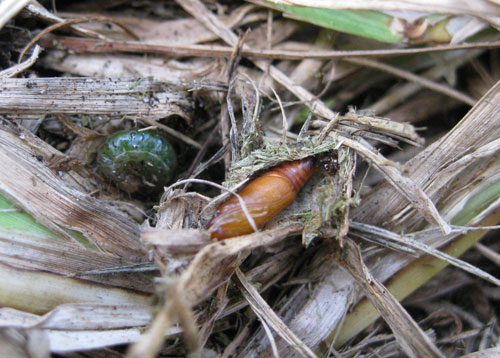
by Matt Lollar | Sep 29, 2016
Tropical sod webworms (Herpetogramma phaeopteralis) have recently been encountered in a number of yards in the Panhandle. The worms usually feed in large groups and unfortunately, the first, and basically the only, sign of damage is often a large area of shorter grass due to their feeding. The arrival time of sod webworms is also unfortunate because they are part of a group of caterpillars that successively attack turf including fall armyworm (Spodoptera frugiperda), striped grass loopers (Mocisspp.), and the fiery skipper (Hylephila phyleus).
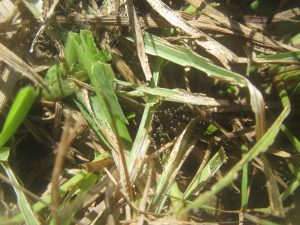
Sod webworm feeding damage in the turf thatch layer. Photo Credit: University of Florida/IFAS Extension.
Description
Larvae
Caterpillars are light yellow to orange with brown spots on each body segment and they have a dark, orange-brown head. They will grow to a full length of slight less than 1/2 inch.
Pupae
The reddish brown pupae are about about 1/4 inch long. The pupae are typically found in the upper thatch layer.
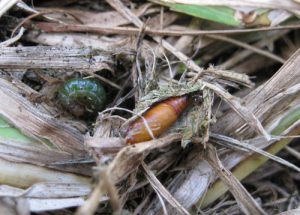
Pupa found in cocoon in St. Augustinegrass thatch. Photo Credit: Steven Arthurs, University of Florida/IFAS
Adults
The moths brown with splotchy wings and are about 3/4 inch wide.
Control
Sod webworms are difficult to control because of their spontaneity. However, in the lawn they hide in the thatch during the heat of the day. Over watering and fertilization can increase the amount of thatch. It is important to follow UF/IFAS guidelines for home lawn management.
The first line of defence is healthy turf. Proper fertilization, irrigation, and mowing height can decrease susceptibility of turfgrass against sod webworm. Over-fertilization is a common cause of caterpillar outbreaks in lawns. Cultural practices such as thatch removal by vertical mowing can help eliminate populations. Eggs are laid on grass blades and removal of grass clippings might also reduce populations.
Numerous chemical control options are available, but softer chemicals such as insecticides containing the bacteria Bacillus thuringiensis are recommended as a first line of defense. Insecticides should be applied in the morning or evening during feeding time. For additional control strategies and basic information please visit the UF/IFAS Sod Webworm Publication.
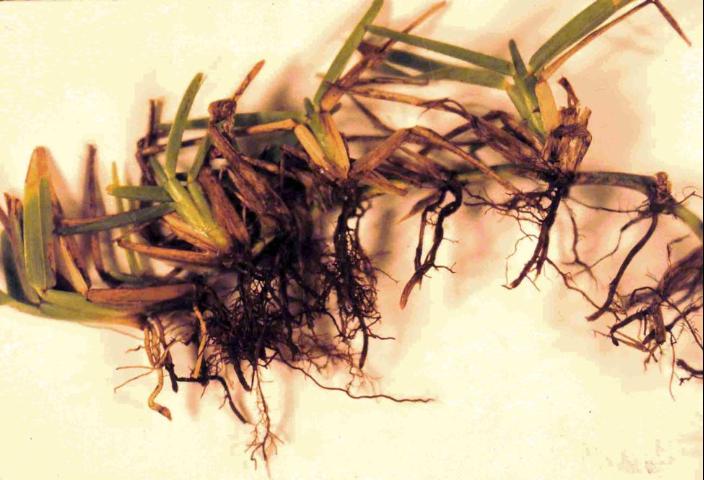
by Blake Thaxton | Sep 29, 2016

St. Augustinegrass roots rotted due to take-all root rot. (Photo Credit: IFAS Photos)
The crisp air of fall is upon us. Maybe. We live in northwest Florida and we are not experiencing the change in weather just yet. With the change in weather coming, we are having specific issues in turfgrass lawns and are sure to have others in the near future. Extension agents in the western panhandle have come into contact with several St. Augustine lawns with symptoms and signs of take-all root rot (Gaeumannomyces graminis var. graminis) and we can soon expect with cooler temperatures for Large Patch to be rearing its ugly head.

Early aboveground symptoms of take-all root rot. (Photo Credit: IFAS Photos)
Take-all root rot is sometimes referred to as a “stress disease”, as it is brought on by stressful weather conditions and improper management. Periods of rainfall can provide conditions for the disease to affect all warm season grasses. Other stresses such as improper mowing height, improper irrigation, and improper fertilization can worsen the situation. For example, St. Augustinegrass, except dwarf cultivars, should be mowed at 3.5 to 4 inches and the mower should never remove more than 1/3 of the leaf blade at any cutting. With the current high temperatures and prolonged periods of rainfall it can be difficult to follow this practice. When a homeowner does not mow the lawn in a timely manner and lets the lawn grass get much too high and cuts more than 1/3 of the grass blade, this can become a stress to the lawn. Fungicide sprays can be made during favorable environmental conditions, before symptoms are seen to protect from infection with take-all root rot for high valued properties. To learn more about take-all root rot refer to this University of Florida/IFAS Extension publication: Take-all Root Rot
With the fall weather coming, please be sure to read and learn about large patch disease as well. This can brought on by temperatures of less than 80 degrees and high humidity or extended periods of rainfall. Read the University of Florida/IFAS Extension publication for more information: Large Patch
For any other information needed regarding proper lawn management, please visit Your Florida Lawn or contact your local UF/IFAS Extension office.
by Les Harrison | Sep 28, 2016
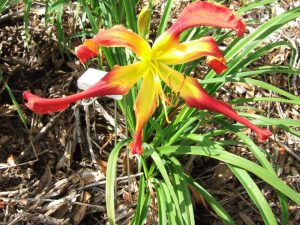
‘Wild Wookie’ Daylily. Photo credit: Sally Menk, Florida Master Gardener.
The daylily is a popular flowering perennial with East Asian origins which has adapted well to Florida landscapes. Plants are available in a wide variety of growth habits, flower shapes and colors, including yellow, orange, red, pink, purple, near-white and shades and combinations of all of these.
Flowering starts in March for early-season bloomers with late-season cultivars starting in mid-May. The typical bloom period is about four to seven weeks, although some varieties bloom even longer.
As their name accurately indicates, daylilies are members of the lily family, in the genus Hemerocallis. “Hemero” is Greek for “day” and “callis” for “beauty,” so the scientific name translates to beauty for a day.
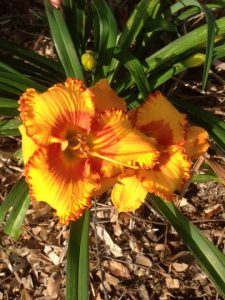
‘Cajun Dreaming’ Daylily. Photo credit: Sally Menk, Florida Master Gardener.
For the adventurous eater, the flower buds and petals of daylilies are edible raw, boiled, stir-fried, steamed, stuffed, or battered and fried. Dried daylily petals, called “golden needles,” are used in numerous Chinese dishes.
Many of the modern varieties of daylilies available today have been developed from native Chinese species. Early settlers from Europe and Asia brought many of the original species with them to America in earlier centuries.
Daylilies grow best in full sun or filtered shade. The darker colored red and purple varieties flourish better in partial shade, while light colored yellows, pinks and pastels varieties need full sun to bring out their best colors. The filtered light level under pine trees is ideal for growing daylilies. Heavy shade should be avoided because it will cause thin, spindly growth and poor flowering.
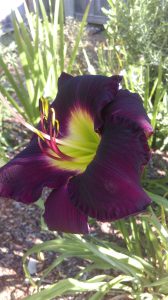
‘Bold Move’ Daylily. Photo credit: Jaci Zwierzchowski, Florida Master Gardener.
The soil of daylily beds should be topped with three to four inches of organic matter, such as peat, compost, or well-rotted manure. The amended soil should be mixed or tilled, leveled and then moistened. The soil pH should be between 6.2 and 6.8, with 6.5 being optimal.
Daylilies survive dry conditions well because of their extensive root systems. However, the number and size of blooms, plant growth, and overall vigor can be adversely affected by prolonged drought.
Daylilies multiply fairly rapidly and plant division is an easy way to propagate them for new locations in the home landscape or to share with friends. Division is best done immediately after the flowering season. Dig the entire clump and shake or wash off the soil without damaging the roots. It is easy to see where the divisions can be made with smaller clumps being easily pulled free to establish a new planting.
The home gardener can expand and share the beauty of these perennials, only spending a little time to accomplish this feat.
To learn more:
Daylilies for Florida
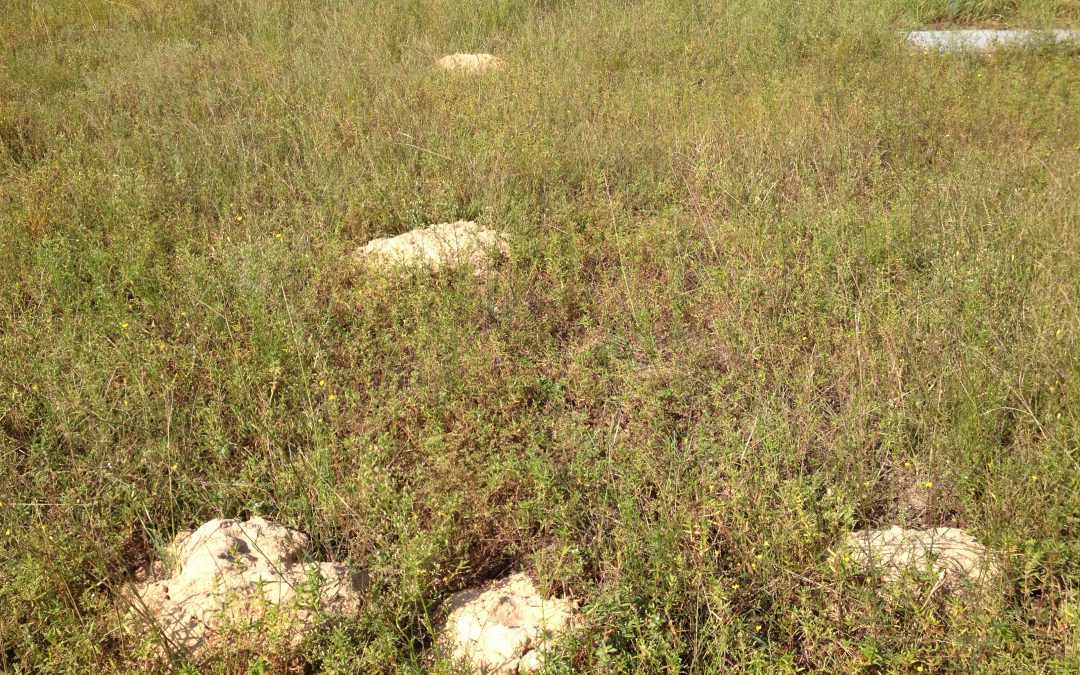
by Larry Williams | Sep 23, 2016

Mounds of sand made my pocket gopher along roadside. Photo Credit: Larry Williams
Pocket gopher is a furry animal known by many locals as “sandy mounder.” It was given this name because of the sandy mounds of excavated earth that the gopher pushes out of its underground burrows. The name sandy mounder, with time, became “salamander.” This animal is not a salamander at all. Salamanders are slimy amphibians shaped like lizards. Salamanders are often known as “spring lizards” in Florida.
To make this nomenclature problem more confusing, in some areas of Florida gopher means a certain burrowing tortoise – the gopher tortoise.
To simplify things keep in mind that in Florida “spring lizard” can mean “salamander” and “salamander” can mean “gopher” and “gopher” can mean “turtle.”
“Gopher” is a confusing word all over the country. Jeff Jackson, retired wildlife biologist with University of Georgia Extension says, “The Richardson’s ground squirrel of the west is called gopher. So is the thirteen lined ground squirrel of the Great Plains and Midwest. Moles are called gophers in many areas. And voles (certain short-tailed mice) are called gophers in some states.”
Jackson says there are six species of “sure enough, genuine pocket gophers in the United States.” Our pocket gopher is the Southeastern Pocket Gopher, found in north Florida, south Alabama and south Georgia.
The pocket gopher spends its time underground making tunnels and nests, eating roots and bearing and raising young. It may venture into residential areas where it can damage plants by feeding on tree and shrub roots or bulbs and tubers of various plants.
A pocket gopher can make fifty or more sandy mounds in a relatively short period of time. These mounds, which are normally four to six inches high and possibly a foot across, are what get homeowners’ attention. The mounds can “popup” overnight in lines or rows. They resemble fire ant mounds; however, they contain no ants.
The pocket gopher is a rodent that grows to about a foot long, has a short tail and weighs about half a pound. Its name comes from the large fur-lined pouches on the outside of its cheeks.
Even though they do contribute to the formation of soil and provide a food source for some predators, sometimes their damage may justify control measures.
Trapping is the most effective option. No chemical repellents are known to be effective. It’s illegal to use any poison to kill gophers. Vibrating devices have not been proven to repel gophers. A long held belief that Wrigley’s Juicy Fruit gum kills gophers by blocking their digestive system has been proven to be false.
A detailed fact sheet is available online at http://edis.ifas.ufl.edu/uw285.

by Mary Salinas | Sep 22, 2016
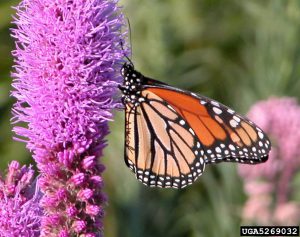
Monarch butterfly on dense blazing star (Liatris spicata).
Beverly Turner, Jackson Minnesota, Bugwood.org
The Florida panhandle has a treasure of native wildflowers to enjoy in every season of the year. In the late summer and fall, blazing star, also commonly known as gayfeather, can be found blooming in natural areas and along roadsides. You can also add it to your landscape to provide beautiful fall color and interest year after year.
Blazing star is a perennial that is native to scrubs, sandhills, flatwoods and upland pines; this makes it a tough plant that can endure drought conditions once it is established. It is ideal for a low-maintenance landscape and is a perfect addition to a butterfly or pollinator garden. The butterflies and bees love it!
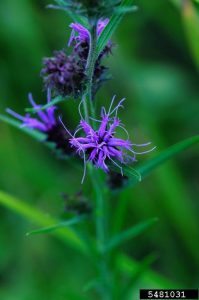
Scaly blazing star (Liatris squarrosa). Photo credit: Vern Wilkins, Indiana University, Bugwood.com.
This beauty grows tall and slender so it is best when planted in masses for an impressive display. This lankiness can result in lodging, or falling over, when the blooms get too heavy but this can be alleviated when grown in masses or with other wildflowers that can support them. The spent flowers will provide your garden with more seed for future years and form a larger colony.

Chapman’s Blazing Star (Liatris chapmanii). Photo credit: Mary Derrick, UF/IFAS.
The home gardener can add blazing star as potted plants or by seeding directly into the soil in October in north Florida. Seeds are available from numerous online sources. Before you purchase, however, make sure that the species you select is a Florida native!
For more information and seed sources:
Florida Wildflower Foundation
Common Native Wildflowers of North Florida













